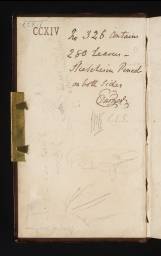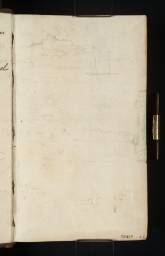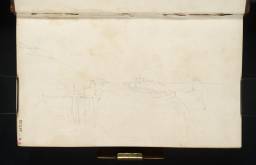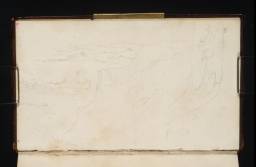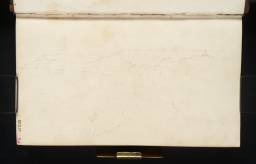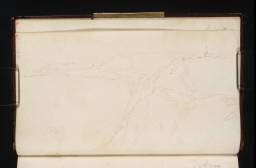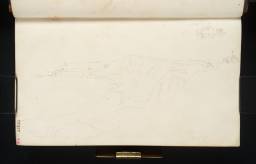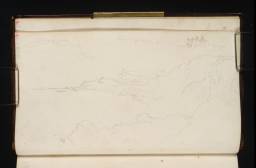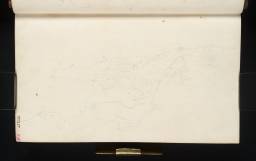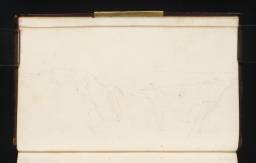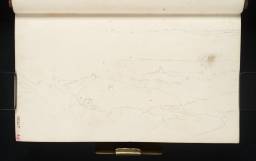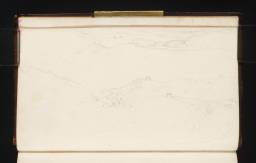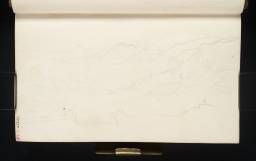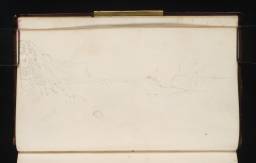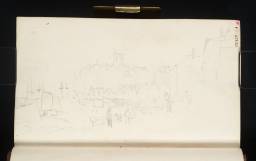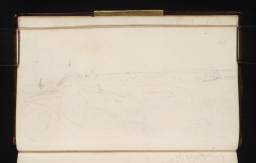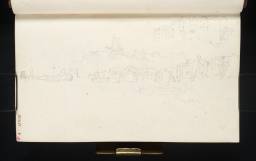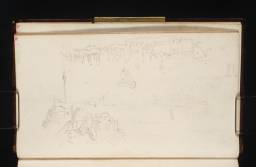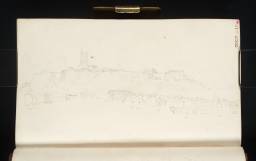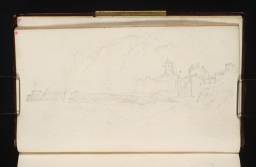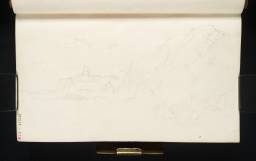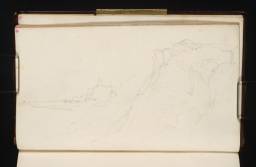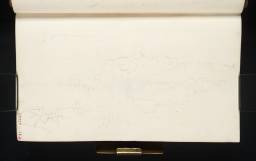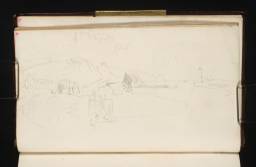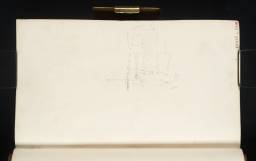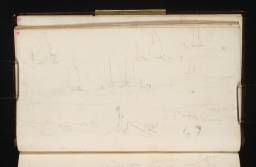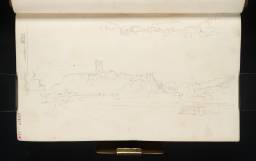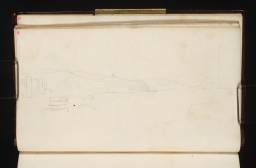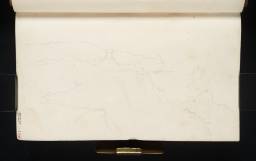Turner Bequest CCXIV 1–282a
Sketchbook bound in boards, covered in brown leather, gilt-ruled with single line around borders of both covers; seven plain gilt rules to spine, with black leather label stamped in gilt ‘ITINERARY | No. I.’; one brass clasp
282 leaves and paste-downs of white wove paper without watermarks; page size 150 x 90 mm
Numbered 326 as part of the Turner Schedule in 1854 and endorsed by the Executors of the Turner Bequest inside front cover (D40991)
Blind-stamped with Turner Bequest monogram on front cover, towards top left
Inscribed in pencil ‘CCXIV’ on white laid paper label (30 x 50 mm) pasted to front cover, towards top
Stamped in black ‘CCXIV’ on front cover, top right
282 leaves and paste-downs of white wove paper without watermarks; page size 150 x 90 mm
Numbered 326 as part of the Turner Schedule in 1854 and endorsed by the Executors of the Turner Bequest inside front cover (D40991)
Blind-stamped with Turner Bequest monogram on front cover, towards top left
Inscribed in pencil ‘CCXIV’ on white laid paper label (30 x 50 mm) pasted to front cover, towards top
Stamped in black ‘CCXIV’ on front cover, top right
Accepted by the nation as part of the Turner Bequest 1856
Exhibition history
References
This compact, lengthy and densely worked sketchbook, ‘with innumerable small pencil sketches of architecture, ships, [and] costume’ which are ‘remarkable for their comprehensiveness’ as Andrew Wilton and Gerald Wilkinson have characterised it,1 was used along with the larger, landscape-format Holland, Meuse and Cologne book (Tate; Turner Bequest CCXV)2 in what are today the Netherlands, Germany and Belgium (the first and last then forming the United Kingdom of the Netherlands), as well as the adjacent northern coast of France, in the early autumn of 1825.
The 282 leaves, almost all with drawings on both sides and sometimes with several to a page, also contain substantial sequences of sketches (amounting to about a fifth of the contents) at each end, showing Dover and other coastal subjects around Kent which relate to watercolours engraved in the last stages of the long-running Picturesque Views on the Southern Coast of England series, as set out towards the end of this Introduction.
Given that the present book covers the entire Continental route of something like six hundred miles, the tour and its circumstances are discussed in detail here rather than in its overall Introduction. The relationship between the sequences of Kent studies, the voyages to and from the Continent and the tour embodied in an effectively continuous sequence through the bulk of the pages, is uncertain, although the implication of Turner’s remarks on the eve of departure was that he would be travelling fairly directly from London to the Netherlands.
Finberg dated this Holland book to 1825 in his 1909 Inventory,3 and Holland, Meuse and Cologne to about the same year,4 but in an unpublished annotation he suggested that the latter’s date was ‘Probably 1826’,5 linking it by implication with other sketchbooks since reassigned to 1824;6 see the other book’s Introduction for the later consensus that both belong to 1825, and the section’s Introduction for the wider context of other tours. In his later biography of the artist, having noted that Turner had told his close friend and patron Walter Fawkes and his wife at dinner on 27 August 1825 that ‘he was going the next morning to the Hague’, Finberg outlined the itinerary as follows:
The only record we possess of this tour is contained in the ‘Holland’ sketchbook. The sketches in it show that he went from Dover to Rotterdam, then through Delft to The Hague, Leyden, and Amsterdam, and from there to Utrecht and Cologne. From Cologne he went to Aix-la-Chapelle, Liège, Antwerp, Ghent, Bruges, and Ostend, returning to London by way of Dover and Deal.7
Fawkes had been in failing health since June, and died on 25 October; there is no record of Turner’s seeing him again before departing or after the tour,8 assuming he was back in the country by then. Ian Warrell has suggested that the journey could have taken ‘five or six weeks’,9 and Cecilia Powell noted that the artist ‘would not have stayed abroad far into October’.10 The British banking crash which began while Turner was away would affect the finances of the Fawkes family (already somewhat perilous) and others among his circle.11 His primary purpose may have been to gather material for a painting for another patron, although it was not necessarily commissioned in advance, nor its subject decided, as discussed below.
The book’s page sequence appears undisturbed, and Finberg’s summary was based on his understanding of its contents. In fact, there are no views of The Hague, the only place specified by Turner before setting out, and Finberg presumably inferred that he passed through on his route between Delft and Leiden (Leyden; see under folio 94 verso; D19026). The only link Finberg made to a subject outside this sketchbook, providing a terminus ante quem, was under folio 273 recto (D19382), a view of Deal, in Kent: ‘See Water Colour, engraved in “Southern Coast,” and published 1st April, 1826’.12 However, as discussed below, studies on the River Rhine at Cologne, recognised in the Inventory without further comment,13 relate to the major painting of the city exhibited later that spring,14 lending further weight to the book’s established dating.
Another point subject to revision here in terms of Finberg’s account, that Turner set sail back to England from Ostend in Belgium, is based on his reading of small, scrawled inscriptions on folios 240 verso and 241 recto (D19316–D19317),15 which likely accounts for his suggestion that the harbour view on folio 243 verso (D19323) showed the town.16 He also read a note on folio 251 recto (D19338) as ‘Ostend Sands’,17 but a quite different interpretation is offered in the present catalogue. In fact, D19323 and adjacent pages show Boulogne, on the French coast about seventy miles south-west of Ostend as the crow flies, which Turner reached by way of Dunkirk and Calais, as set out in the detailed itinerary which follows.
The artist probably returned directly from Boulogne across the English Channel, most likely to Dover or Folkestone, although Whitstable, on the northern coast of Kent, is the first of the confirmed subjects following on from Boulogne as foliated. Perhaps Turner worked inwards from the back to fill the remaining pages. This reading and the assumption that he had initially sailed from Dover or Folkestone (see under folios 2 recto and 8 recto respectively; D18843, D18855) direct to Rotterdam makes the most straightforward sense of the sketchbook’s sequence. Previous interpretations have included Turner’s beginning at Boulogne and departing from Calais,18 or vice versa,19 or beginning and ending at Boulogne.20
Finberg 1909, II, p.650; as followed in subsequent sources, including Bachrach 1974, pp.20, [47], Wilton 1974, p.101, Wilkinson 1975, p.32, von der Borch and Bott 1980, pp.68–9, 70, Shanes 1981, p.153, Butlin and Joll 1984, p.142, Wilton 1987, p.166, Powell 1991, pp.44, 61 note 35, 119, Warrell 1991, p.48, Bachrach 1994, pp.19, 26, Powell 1995, pp.33–4, Warrell 1997, pp.17, 206 note 21, Wilton 2006a, p.76, Wilton 2006b, p.236, and Warrell 2014, p.138.
Undated MS note by Finberg (died 1939) in interleaved copy of Finberg 1909, Prints and Drawings Room, Tate Britain, II, opposite p.662; Wilton 1987, p.166, adopted 1826 for the other sketchbook, but they were both placed at 1825 in Wilton 2006, p.236.
Finberg 1961, p.291; the Continental itinerary is followed closely in Jack Lindsay, J.M.W. Turner: His Life and Work: A Critical Biography, London 1966, p.164, Wilton 1987, p.166, Powell 1991, p.119, Warrell 1991, p.48, Bachrach 1994, p.19, and Wilton 2006b, p.236.
See Finberg 1961, p.291; see also Bachrach 1994, p.19, Anthony Bailey, Standing in the Sun: A Life of J.M.W. Turner, London 1997, pp.221–2, and Franny Moyle, The Extraordinary Life and Momentous Times of J.M.W. Turner, London 2016, p.324.
See Finberg 1961, p.294, Lindsay 1966, p.164, and James Hamilton, Turner: A Life, London 1997, p.255.
See David Blayney Brown, ‘Coasting: Turner, Bonington and Some Contemporaries on the Shores of the Channel’ in Brown, Sarah Skinner and Ian Warrell, Coasting: Turner and Bonington on the Shores of the Channel, exhibition catalogue, Nottingham Castle 2008, pp.25, 27.
See Maurice Guillaud in Guillaud, Nicholas Alfrey, Andrew Wilton and others, Turner en France: aquarelles, peintures, dessins, gravures, carnets de croquis / Turner in France: Watercolours, Paintings, Drawings, Engravings, Sketchbooks, exhibition catalogue, Centre Culturel du Marais, Paris 1981, p.[171], in relation to the Holland, Meuse and Cologne sketchbook.
The Continental itinerary:
After a few pages of shipping studies, Turner entered the estuary of the Nieuwe Maas (New Meuse), possibly sketching Schiedam as he passed upriver (see under folio 26 recto; D18890), then Brielle (Brill), perhaps Oostvorne, and Maassluis (see under folios 29 verso, 30 verso and 34 recto; D18897, D18899, D18906) before reaching Rotterdam (see under folio 35 recto; D18908). The city is one of the few sites also covered in the Holland, Meuse and Cologne sketchbook, the others being marked within this itinerary with asterisks. Long sequences there are interspersed with shorter runs at nearby Dordrecht (see under folio 47 recto; D18931), apparently during a brief excursion by river there and back, and Amsterdam (see under folio 81 recto; D18999). The latter comprise a few pages some way ahead of the main sequence in that city, and may have been filling in a few leaves inadvertently missed during the Rotterdam stay. The Dutch Turner scholar Fred Bachrach reproduced and discussed numerous views of Rotterdam, Dordrecht and their surroundings in considerable detail.21
From Rotterdam, Turner’s route took him briefly west to Delft, and then by waterways north-eastwards to Leiden (Leyden; see respectively under folios 93 recto and 95 recto; D19023, D19027), apparently bypassing The Hague; the first confirmed view in the second Amsterdam* sequence is on folio 97 recto (D19031). After a thorough survey of the city and the adjacent River IJ, he continued south-eastwards to Utrecht (see under folio 128 verso; D19093). Rhenen, on the rural River Nederrijn south-east of Utrecht (folio 132 recto; D19100), is the last Dutch subject except Maastricht, much further on.
Eastwards from Rhenen he reached Kleve (Cleves; see under folio 132 verso; D19101) and the nearby River Rhine, travelling south-eastwards up the reaches north of Cologne for the first time,22 by way of Neuss (folio 137 verso; D19111) and Düsseldorf* (see under folio 138 recto; D19112). Having surveyed Cologne* at some length, largely from the river (see under folio 141 recto; D19118), he headed west overland for Aachen (Aix–la–Chapelle; see under folio 151 verso; D19139) and reached his first Belgian stop, Liège* on the River Meuse (see under folio 155 verso; D19147).
He then progressed downstream a few miles to the north past Hermalle, Argenteuse and Visé (folios 175 recto–178 recto; D19186–D19192), briefly returning to the modern Netherlands at Maastricht* (see under folio 179 verso; D19195). The north-westward route back into Belgium, likely overland, is unclear, but possibly by way of Mechelen (Malines; folios 187 verso–188 recto; D19211–D19212), until Turner reached Antwerp on the River Scheldt (see under folio 188 recto; D19212). From there he headed west to Ghent and Bruges (see under folios 201 verso and 218 recto; D19239, D19272), and along canals parallel with the North Sea coast through Nieuwpoort and Veurne (Furnes; folios 223 verso–226 recto; D19283–D19288).
The 1826 Cologne painting:
Following his previous year’s tour (see Alice Rylance-Watson’s ‘Meuse-Mosel, Luxembourg and Northern France 1824’ section in the present catalogue), Turner’s sole exhibit at the Royal Academy in the early summer of 1825 had been the major oil painting Harbour of Dieppe (Changement de Domicile) (Frick Collection, New York).23 Likewise, the only work to result directly from the subsequent 1825 journey would be Cologne, the Arrival of a Packet Boat, Evening, shown at the same venue in 1826 (also Frick Collection);24 for related Cologne sketches and further discussion, see under folio 143 recto (D19122). The paintings are of similar large sizes and loosely comparable in terms of their waterside settings and lambent atmosphere.
Dieppe had apparently been commissioned by the London collector John Broadhurst, but it is not clear that the same applied to Cologne, although he did later come to own it, apparently in 1827. Broadhurst’s wider patronage of Turner around this time and the other large paintings produced for him or perhaps with him in mind have been explored in detail by Ian Warrell.25 Having initially posited Cologne as a direct commission,26 Powell later suggested that Broadhurst may rather have suggested ‘a Dutch type of subject for his picture’,27 assuming he had any direct input. This lack of an exact specification may account for Turner’s equally intensive study of numerous other waterside town and cities along his 1825 route.
The Dieppe scene, with its brilliant sun towards the centre of the sky and reflected in the water, owed much to Turner’s long-standing admiration for the seaport paintings of the French-born (albeit Rome-based) Claude Lorrain (1604/5–1682).28 By contrast, Powell has argued that the subsequent focus on the busy Cologne riverfront (in softer evening light from one side) rather than a major vista meant the ‘chief force’ behind the composition was ‘not the picturesque Middle Rhine but the sights Turner had been enjoying earlier on the tour’,29 affected by his admiration for seventeenth century Dutch art as embodied in the main outcome of his 1817 tour, the painting Dort, or Dordrecht, the Dort Packet-Boat from Rotterdam Becalmed (Yale Center for British Art, New Haven).30 On much the same scale as the Dieppe and Cologne canvases, it too had been exhibited at the Royal Academy, in 1818, and had been acquired by Fawkes. Powell has speculated that the Cologne painting might have been ‘in a very different manner’ had it been undertaken ‘at any other moment than straight after an extensive tour of Holland’;31 it was ‘painted according to one of the great traditions of European art but transformed by [Turner’s] own sense of light and colour.’32
Ibid., pp.141–3 no.232, pl.235 (colour); see also von der Borch and Bott 1980, p.69, and Warrell 1991, p.48.
See Ian Warrell, Turner on the Loire, exhibition catalogue, Tate Gallery, London 1997, pp.172–181; see also Butlin and Joll 1984, pp.140–2, and for both Frick paintings in context, Susan Grace Galassi, Ian Warrell, Joanna Sheers Seidenstein and others, Turner’s Modern and Ancient Ports: Passages through Time, exhibition catalogue, Frick Collection, New York 2017.
See Ian Warrell, Blandine Chavanne and Michael Kitson, Turner et le Lorrain, exhibition catalogue, Musée des beaux-arts, Nancy 2002, Ian Warrell and others, Turner Inspired: In the Light of Claude, exhibition catalogue, National Gallery, London 2012 and, in relation to the Dieppe painting, Susan Grace Galassi, ‘Liminal Spaces: Turner’s Paintings of Dieppe and Cologne’ in Galassi and others 2017, p.69.
Dutch art and the sketchbook’s wider subject matter:
Given Turner’s perennial fascination for marine and river subjects, the Dutch waters would have reminded him of the paintings he greatly admired by the country’s seventeenth-century artists, such as the younger Willem van de Velde (1633–1707) and Salomon van Ruysdael (1600/3–1670). Turner’s 1827 painting Port Ruysdael (Yale Center for British Art, New Haven),33 pays oblique acknowledgement to Salomon’s nephew Jacob van Ruisdael (1628/9–1682), and in the 1830s he exhibited a number of marine paintings in this mode, such as Van Goyen Looking out for a Subject off Antwerp (Frick Collection, New York)34 and the Rotterdam Ferry Boat (National Gallery of Art, Washington DC),35 both exhibited at the Royal Academy in 1833. The present book reflected this longstanding aspect of Turner’s art, with nearly two hundred pages featuring shipping more or less prominently:
inside the front cover (D40991) and folios 13 recto and verso, 19 recto, 23 recto, 24 verso–26 recto, 27 recto–29 verso, 30 verso–35 recto, 36 recto and verso, 38 verso–40 verso, 45 verso–50 recto, 52 recto–54 recto, 55 recto–56 recto, 58 recto–59 verso, 61 recto–62 recto, 63 recto, 64 verso–66 recto, 74 recto and verso, 76 recto and verso, 78 recto, 79 recto, 80 recto and verso, 82 recto–84 verso, 85 verso, 89 recto–90 recto, 91 recto–92 recto, 93 recto, 94 recto, 95 recto, 98 verso, 103 verso–104 verso, 106 verso–108 recto, 109 verso, 110 verso–111 verso, 112 verso–113 verso, 115 recto and verso, 116 verso, 117 recto, 119 verso, 121 recto, 122 recto, 123 recto–126 recto, 128 recto–129 recto, 131 recto, 133 recto, 134 recto, 138 recto, 139 recto, 141 verso–142 verso, 144 recto, 145 recto, 146 recto and verso, 147 verso, 149 recto–150 verso, 164 verso, 165 verso, 166 recto, 168 recto, 170 recto, 171 verso, 172 verso, 174 recto, 177 verso, 180 verso, 181 recto, 185 recto, 188 recto, 189 verso–190 verso, 196 recto, 199 verso, 200 verso, 201 recto, 204 recto and verso, 206 recto, 209 verso, 210 recto, 214 recto and verso, 215 verso, 216 recto, 217 recto and verso, 221 verso–222 recto, 223 recto–224 recto, 225 verso, 226 verso, 227 recto, 229 recto, 231 recto, 233 verso, 236 recto, 238 recto and verso, 240 recto, 244 recto, 246 recto and verso, 247 verso, 248 verso, 250 verso, 251 recto, 255 verso–256 recto, 263 recto–264 verso, 265 verso, 272 verso, 273 recto, 277 recto and verso, 278 verso, 282 verso (D18865–D18866, D18877, D18884, D18887–D18890, D18892–D18897, D18899–D18908, D18910–D18911, D18915–D18919, D18928–D18937, D18941–D18945, D18947–D18949, D18953–D18956, D18959–D18961, D18963, D18966–D18969, D18985–D18986, D18989–D18990, D18993, D18995, D18997–D18998, D19001–D19006, D19008, D19015–D19017, D19019–D19021, D19023, D19025, D19027, D19034, D19044–D19046, D19050–D19053, D19055, D19057–D19059, D19061–D19063, D19066–D19067, D19069–D19070, D19075, D19078, D19080, D19082–D19088, D19092–D19094, D19098, D19102, D19104, D19112, D19114, D19119–D19121, D19124, D19126, D19128–D19129, D19131, D19134–D19137, D19165, D19167–D19168, D19172, D19176, D19179, D19181, D19184, D19191, D19197–D19198, D19206, D19212, D19215–D19217, D19228, D19235, D19237–D19238, D19244–D19245, D19248, D19255–D19256, D19264–D19265, D19266–D19268, D19270–D19271, D19279–D19280, D19282–D19284, D19287, D19289–D19290, D19294, D19298, D19303, D19308, D19312–D19313, D19316, D19324, D19328–D19329, D19331, D19333, D19337–D19338, D19347–D19348, D19362–D19365, D19367, D19381–D19382, D19389–D19390, D19392, D19400)
Turner’s interest in modern developments means this tally includes numerous steam-powered craft, then relatively novel but rapidly transforming sea and river travel (see D18907, D18967, D18993, D19042, D19228–D19229, D19299, D19313, D19363–D19365).
Meanwhile, his awareness of his predecessors is reflected in various notes and sketches. In particular, three pages of directly observed drawings include inscriptions invoking ‘Cyp’ (sic), the landscape painter Aelbert Cuyp (1620–1691);36 see under folio 60 verso (D18958). Indeed, the Amsterdam river view on folio 117 verso (D19071) struck him as ‘quite a Cyp’, while (apparently uniquely in terms of the sketchbooks), folio 131 verso (D19099) bears the name of Cuyp’s contemporary Meindert Hobbema (1638–1709). Turner evidently visited the Rijksmuseum collection, then housed in Amsterdam’s Trippenhuis, copying an interior with figures by Gerard ter Borch the younger (1617–1681; folio 81 recto; D18999). Another figure scene (folio 101 recto; D19039) is likely a copy of an unidentified composition, perhaps by a contemporary of Rembrandt (1606–1669). Turner was a confirmed admirer,37 exhibiting one of his own paintings specifically emulating his style, Rembrandt’s Daughter (Fogg Art Museum, Cambridge, Massachusetts),38 at the Royal Academy in 1827, along with Port Ruysdael; see also the crowd scene with Pilate Washing his Hands shown there in 1830 (Tate N00510).39
Turner especially admired Cuyp for his serene light and atmosphere, and this feeling is evoked in the sketches here, albeit generally in outline alone with characteristic annotations regarding light effects and colours, sometimes showing the sun reflected in water and occasionally with selective contre jour shading. These effects are secondary to an exhaustively ‘plain record of things seen’ as Wilkinson put it,40 while Bachrach has observed: ‘As is also apparent from his sketchbooks of other European travels, he consistently visited the same places, again and again sketching in varying styles the same views or buildings, as if to check previous impressions and check his memory for detail’,41 for instance all around Rotterdam’s Oude Haven, resulting in a series of drawings in both 1825 sketchbooks. As quoted in individual entries, Wilton has taken various Rotterdam views as case studies, describing ‘Turner’s sure instinct for what it was necessary to express in line and what could be omitted, or left to his memory to supply’, which ‘results in drawings that unerringly group and compose, or perhaps more accurately suggest compositions’.42 Wilton summarised the effect: ‘Nothing extraneous to the immediate purpose of registering the scene is needed or admitted, yet the whole view comes to life in this vividly pregnant shorthand.’43
Wilkinson has suggested that the ‘awareness and curiosity’ demonstrated by this book ‘are those of a boy, not of a seasoned R.A. of 50.’44 Over eighty comprise or include everyday scenes with figures going about their business, and studies of individuals, their costume and (frequently) headgear, culminating in the 1826 Cologne painting, with its festive array of bonnets sported by the women arriving on the sunlit boat contrasted with the plain working clothes of the women in the shadowy woodyard on the bank:
folios 37 verso, 43 verso, 46 verso, 48 recto, 50 recto, 52 verso, 55 recto–56 recto, 57 recto and verso, 65 recto and verso, 69 verso, 81 verso, 83 verso, 84 recto, 86 verso, 94 verso, 103 verso, 104 recto, 107 recto, 120 verso, 121 recto, 122 recto, 123 verso, 124 verso, 125 verso, 128 verso, 131 recto and verso, 137 recto, 138 recto–139 verso, 140 verso, 142 recto, 144 verso, 145 recto, 148 verso, 149 verso, 151 recto, 154 verso, 159 recto, 165 verso, 169 recto, 171 verso–174 verso, 175 verso, 176 verso, 178 verso, 196 verso, 199 recto, 207 verso–208 verso, 213 verso, 215 recto–216 verso, 222 verso, 223 recto, 224 recto, 225 recto, 230 verso, 231 recto, 232 recto, 236 recto, 237 verso, 238 verso, 240 verso, 241 recto, 247 verso, 248 verso, 263 recto, 268 verso, 273 recto, 277 recto, 282 recto, and inside the back cover (D18913, D18925, D18930, D18933, D18937, D18942, D18947–D18949, D18951–D18952, D18967–D18968, D18976, D19000, D19004–D19005, D19010, D19026, D19044–D19045, D19051, D19077–D19078, D19080, D19083, D19085, D19087, D19093, D19098–D19099, D19110, D19112–D19115, D19117, D19120, D19125–D19126, D19133, D19135, D19138, D19145, D19154, D19167, D19174, D19179–D19185, D19187, D19189, D19193, D19229, D19234, D19251–D19253, D19263, D19266–D19269, D19281–D19282, D19284, D19286, D19297–D19298, D19300, D19308, D19311, D19313, D19317–D19318, D19331, D19333, D19362, D19373, D19382, D19389, D19399, D40992)
These include various market scenes (D18925, D18952, D19000, D19010, D19113, D19221); see also Tate D19422 and D19498 (Turner Bequest CCXV 13, 60) in the Holland, Meuse and Cologne book, and compare the busy Dutch and Belgian street scenes in 1819 drawings by George Robert Lewis of Amsterdam and Louvain (Tate T09517, T09516). There are also numerous complementary studies of crockery, jars, utensils and baskets: folios 43 recto, 81 verso, 83 verso, 98 verso, 101 verso, 114 recto, 138 verso, 139 recto, 142 recto, 144 verso, 146 verso, 172 verso, 203 recto, 217 recto (D18924, D19000, D19004, D19034, D19040, D19064, D19113–D19114, D19120, D19125, D19129, D19181, D19242, D19270).
Finally, this encyclopaedic treatment extends to include ducks and storks (inside the front cover and folio 98 verso; D40991, D19034), cows (folios 60 verso and 117 verso; D18958, D19071), horses and donkeys being ridden or pulling carts, carriages and barges (59 verso, 131 recto, 139 verso, 156 verso, 175 verso, 177 verso, 196 verso, 207 verso, 208 recto, 224 verso, 225 recto (D18956, D19098, D19115, D19149, D19187, D19191, D19229, D19251, D19252, D19285, D19286), wheeled vehicles including barrows, carts and carriages (folios 86 verso, 124 verso, 131 verso, 173 verso, 218 recto, 237 verso; D19010, D19085, D19099, D19183, D19272, D19311) and even a travelling theatre (folio 102 recto; D19041).
The Kent subjects and the ‘Picturesque Views on the Southern Coast’:
The sketchbook’s first twenty or so leaves comprise views of Dover, Folkestone and the cliffs of the English Channel coast of Kent around and between them. Immediately following the sequence at Boulogne rounding off the core Continental section, which ends with a page likely showing fisherfolk there (folio 248 verso; D19333), the focus appears to change immediately to Kent again, with three views proposed here as of Faversham, just inland from the county’s northern Thames Estuary coast (folios 249 recto–250 recto; D19334–D19336). A few pages around nearby Whitstable are also newly identified here (see under folio 251 recto; D19338), followed by a long series around the harbour and castle at Dover (folios 253 verso–272 verso; D19343–D19381), shorter sequences at nearby Deal (see under folio 279 verso; D19394) and Walmer (folios 279 verso–280 verso; D19394–D19396), each including their castles, and a few more around Folkestone at the very end of the book (see folios 281 recto–282 verso and likely inside the back cover; D19397–D19400, D40992).
As suggested above, Turner perhaps worked inwards from the back cover after returning from France to Dover or Folkestone until the book was full. Numerous sketches can be linked with watercolours engraved in 1826 for the last parts of the long Southern Coast series, issued periodically since 1814 and ultimately as a book, published by John and Arthur Arch and others as Picturesque Views on the Southern Coast of England, from Drawings Made Principally by J.M.W. Turner, R.A. and Engraved by W.B. Cooke, George Cooke, and Other Eminent Engravers (London 1826). For more on the project, see Matthew Imms’s ‘Southern Coast Colour Studies c.1811–28’ section earlier in the present catalogue.45
A copy with volumes I and II bound as one is held in Tate Britain’s Prints and Drawings Room, and separately accessioned plates in the Tate Collection are noted below, where the designs to which sketches identified here can be related are listed as numbered and titled in the 1826 edition. This presented the series in a geographical sequence, clockwise from Whitstable in Kent to Watchet in Somerset, following the coast from the Thames Estuary via the South Coast to the Bristol Channel. Assuming the suggested connections are correct,46 and that the drawings are from soon before or after the autumn 1825 tour embodied in the rest of this sketchbook, Turner must have prepared the watercolours very rapidly to allow for the engravers’ work.
Vol.I, pl.1. Whitstable, Kent. Watercolour (private collection); engraving dated 8 May 1826: Tate impressions: T04425–T04427, T05218–T05220, T06001.47 Sketches: aspects of folios 251 recto–252 verso (D19338–D19341); see also folios 250 verso and 253 recto (D19337, D19342).
Vol.I, pl.5. Deal, Kent. Watercolour (Deal Town Council); engraving dated 1 April 1826: Tate impressions: T04422, T05236–T05237, T05998.48 Sketches: folios 274 recto, 276 recto (D19383, D19387), and aspects of adjacent views; colour studies: Tate D25410, D25426 (Turner Bequest CCLXIII 287, 303); possible related colour studies: Tate D25437, D36117 (Turner Bequest CCLXIII 314, CCCLXIV 270), D41484 (the verso of the latter).
Vol.I, pl.10. Dover from Shakespeare’s Cliff. Watercolour (currently untraced); engraving dated 6 May 1826: Tate impressions: T04424, T05246–T05251. 49 Sketch: folio 2 recto (D18843); see also folios 256 verso, 257 verso, 265 verso, 266 recto and verso, 268 verso, 269 recto and 271 recto (D19349, D19351, D19367–D19369, D19373–D19374, D19378); colour study: Tate D25392 (Turner Bequest CCLXIII 269).
In addition, the watercolour Dover (Tate D18154; Turner Bequest CCVIII U),51 engraved for Ports of England in 1827 (Tate impressions: T04828–T04829), has been linked to folios 256 verso and 272 verso (D19349, D19381),52 while the watercolour Folkestone Harbour and Coast to Dover, engraved in 1831 for the Picturesque Views in England and Wales (Yale Center for British Art, New Haven),53 appears informed by folios 12 verso, 13 verso, 14 verso and 17 recto (D18864, D18866, D18868, D18873). A few complementary Dover views in the Holland, Meuse and Cologne sketchbook may be connected with the Southern Coast and Ports designs, as noted in its Introduction.
Finberg did not record a ‘wrapper’ of the sort on which John Ruskin often recorded brief topographical remarks, comments and judgements, and in the absence of such a note or a label by Turner the sketchbook’s one-word title was presumably coined for the 1909 Inventory, without incorporating the generic wording stamped in gold on the spine’s leather label, ‘ITINERARY No. I.’, which was likely already present when Turner acquired the volume.
MS notes by the Turner scholar C.F. Bell (died 1966) and Finberg himself (died 1939) on the subjects of individual drawings in copies of the Inventory held at the Tate Britain Prints and Drawings Room are quoted in relevant entries. This text and many of the entries for individual pages are jointly signed by the Dutch art historian Quirine van der Meer Mohr (temporary Researcher on the Dutch and Belgian material in the Turner Bequest, on placement from the University of Utrecht in 2013–14) and Matthew Imms, who has subsequently expanded on her notes and suggestions, as well as addressing the book’s English and German subjects.
See also Alfred (Fred) Bachrach, ‘Cuyp, Aelbert (1620–91)’ in Evelyn Joll, Martin Butlin and Luke Herrmann eds., The Oxford Companion to J.M.W. Turner, Oxford 2001, p.69.
Ibid., pp.185–6 no.332, pl.335 (colour); for this phase of Turner’s work, see Bachrach 1994, p.19, and the paintings grouped together ibid., pp.46–59 nos.11–21.
Several of the Dover and Deal subjects are as noted in Shanes 1981, p.153, which does not mention Whitstable or Folkestone in relation to this sketchbook.
Technical notes
How to cite
Matthew Imms and Quirine van der Meer Mohr, ‘Holland Sketchbook 1825’, sketchbook, September 2020, in David Blayney Brown (ed.), J.M.W. Turner: Sketchbooks, Drawings and Watercolours, Tate Research Publication, March 2023, https://www

